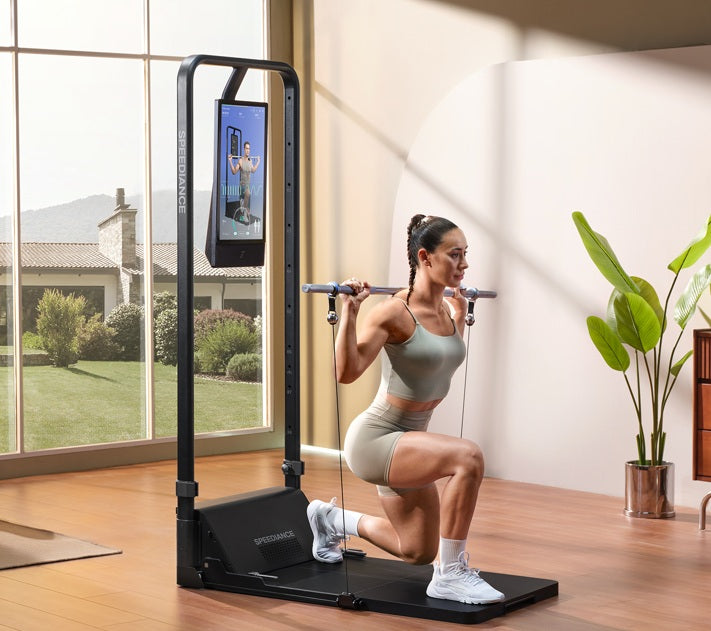

Speed, strength, and power are the pillars of elite athletic performance. Velocity-Based Training (VBT) is a revolutionary strength training method that uses movement speed to optimise resistance levels, ensuring athletes train at the ideal intensity for peak performance. By leveraging real-time velocity data, VBT enhances force production, prevents unnecessary fatigue, and tailors workouts to individual readiness. In this guide, we’ll explore the science behind VBT, its practical applications, and how to integrate it into your training for explosive results.
How Does Velocity-Based Training Work?
Traditional strength training relies on fixed percentages of a lifter’s one-rep max (1RM). However, daily fluctuations in fatigue, recovery, and performance levels can make fixed percentages inefficient. VBT offers a dynamic approach, adjusting load and intensity based on movement speed to ensure optimal power output in every session.
Instead of relying solely on weight, VBT systems track bar speed and provide instant feedback, helping athletes refine their technique, maintain power, and avoid excessive fatigue. When an athlete’s speed drops below the target velocity zone, it signals neuromuscular fatigue, prompting load adjustments to maintain training effectiveness.
The Science: The Force-Velocity Curve
The force-velocity curve is the foundation of VBT, showing the relationship between force production and movement speed:
-
Maximal Strength (High Force, Low Velocity) – Heavy loads moved at slow speeds (e.g., powerlifting).
-
Strength-Speed (Moderate Force, Moderate Velocity) – Lifting moderate weights at high force (e.g., Olympic lifts).
-
Speed-Strength (Low Force, High Velocity) – Moving light weights at high speeds (e.g., plyometrics, jumps).
-
Maximal Velocity (Minimal Force, Highest Speed) – Pure speed training (e.g., sprinting, medicine ball throws).
By tracking velocity zones, athletes can train smarter, optimising performance based on their specific goals rather than a one-size-fits-all percentage system.
Why Power Athletes Need Velocity-Based Training
1. More Efficient Strength Gains
VBT ensures each rep is performed at peak power output, making workouts more effective and time-efficient.
2. Improved Explosive Power
By targeting fast-twitch muscle fibres, VBT increases the rate of force development (RFD), crucial for sprinters, weightlifters, and contact sport athletes.
3. Fatigue Management & Injury Prevention
Unlike fixed-percentage training, VBT adjusts in real time to prevent overtraining, ensuring athletes maintain power without excessive strain.
4. Precision Training for Sport-Specific Demands
Different sports require different power outputs. VBT allows athletes to train within precise speed zones to match their competitive demands.
5. Enhanced Recovery & Adaptation
By monitoring daily readiness, VBT helps structure workouts around an athlete’s optimal performance window, improving long-term gains.
Top Exercises for Velocity-Based Training
Explosive Squats for Lower Body Power
Squats with velocity tracking ensure that lifters generate maximum force, enhancing acceleration and power output. The Speediance Gym Monster 2.0 provides real-time adjustments for seamless power development.
Olympic Lifts for Dynamic Strength
Snatches and clean & jerks rely on speed-strength principles. Using velocity sensors ensures optimal bar path efficiency and peak power generation.
Speed Deadlifts for Acceleration
Fast pulls with VBT monitoring train triple extension mechanics, improving force output in sprinting and jumping sports.
Plyometric Box Jumps for Explosiveness
Jumping exercises with velocity tracking ensure each rep meets peak speed, refining fast-twitch muscle activation.
Sprint Sled Pushes for Speed & Strength
By tracking sled velocity, athletes can fine-tune resistance levels to optimise sprint mechanics.
Implementing Velocity-Based Training
Step 1: Identify Your Training Focus
Determine whether you need maximal strength, power, or speed development, and choose exercises accordingly.
Step 2: Establish Velocity Ranges
Each performance goal corresponds to a velocity range:
-
Maximal Strength (0.15-0.35 m/s) – Heavy strength work (e.g., squats, deadlifts).
-
Strength-Speed (0.35-0.75 m/s) – Explosive lifts (e.g., power cleans, push presses).
-
Speed-Strength (0.75-1.0 m/s) – Acceleration-focused training (e.g., loaded jumps, medicine ball throws).
-
Maximal Velocity (>1.0 m/s) – Sprinting and plyometric training.
Step 3: Integrate Smart Gym Technology
The Speediance Smart Gym ensures automatic load adjustments to keep lifters in the right velocity zone.
Step 4: Monitor & Adjust Workloads
Use real-time feedback to tweak intensity based on daily neuromuscular readiness.
Step 5: Track Progress & Adapt
Regularly monitoring bar velocity enables long-term strength and speed tracking, leading to sustainable performance improvements.
Common Mistakes When Using Velocity-Based Training
1. Using Too Heavy or Too Light Loads
VBT is most effective when loads match the target velocity zone. Training outside these zones limits effectiveness.
2. Neglecting Speed Work in Strength Training
Many athletes focus solely on maximal strength and overlook speed-strength work, which is critical for explosive performance.
3. Ignoring Recovery Metrics
VBT helps manage fatigue accumulation. Not adjusting load or volume accordingly can lead to overtraining.
4. Overcomplicating Training
VBT should enhance training, not complicate it. Stick to fundamental movements and adjust progressively.
Upgrade Your Training with These Accessories
Take your velocity-based training to the next level with these must-have gym accessories:
-
Storage Rack – Keep training gear organised for a clutter-free gym setup.
-
Squat Belt – Provide core stability and reduce injury risk.
-
Rowing Bench – Enhance explosive endurance with rowing-based power drills.
-
Belt Extender – Achieve a custom fit for your weight belt.
Train Smarter, Move Faster, Dominate the Competition
Velocity-based training is redefining strength programming for power athletes. Whether you’re a weightlifter, sprinter, or team sport athlete, incorporating velocity tracking ensures maximal force production, precise load management, and optimised speed training.
Unlock the future of strength training with Speediance Gym Monster 2.0, or book a demo session to see how real-time resistance adjustments can transform your workouts.
For expert recommendations on integrating VBT into your routine, contact us via our contact page and take your power training to the next level!
